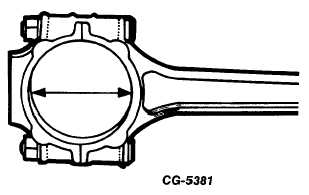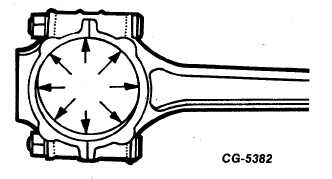|
| |
ENGINE DIVISION SERVICE MANUAL TM 5-4210-230-14&P-1
ENGINE
However, when reboring the cylinder bore, it should
be sized to within .003" of the desired size and then honed to
provide the proper finish on the cylinder wall as well as the
correct running clearance for the piston selected.
Piston pins should be inspected and measured for
wear. If piston pins show signs of corrosion or etching or are
not within specifications, they should be replaced with new
pins. See "Specifications.' Piston assemblies furnished for
service replacement are complete with piston pins accurately
fitted.
Connecting Rods
The connecting rod and bearing must withstand
extreme forces and high temperatures. In addition, the
connecting rod and bearing are subject to changing
temperature cycles in a variety of climates and under widely
varying operating conditions.
The connecting rod bearing plays a major role in
distributing the proper amount of oil to the piston pin bearing
surfaces, cylinder walls, piston and piston rings. This is
known as oil throw-off and the condition of the connecting rod
bearing determines how well the lubrication operation is
performed.
The bearing-to-crankshaft clearance affects the
volume of oil throw-off. Where the bearing clearance is more
than specified, an abnormal amount of oil is thrown onto the
cylinder walls causing increased oil consumption and low oil
pressure due to oil passing through the bearing surfaces too
quickly. Where bearing clearances are less than the specified
amount, the oil that passes through the bearing is insufficient
to properly cool the bearing, resulting in short bearing life and
improper oil throw-off to the cylinder walls, piston pins and
piston rings. This condition contributes to scoring of pistons
and cylinder walls.
If the connecting rod bore is stretched or out-of-round
beyond the specified diameter, the insert will be out-of-round
and will not be held securely in the connecting rod since the
"crush" may be lost. Bearing failures can result from localized
bearing loads or from low oil pressure. The bearing insert
locating tangs will keep the inserts from turning in the
connecting rod bore under normal conditions but may move
and fail due to the foregoing reasons
When installing new connecting rod bore inserts, a
very thorough inspection of the connecting rod bore is
necessary. This inspection consists of the following:
Fig. 88
1.
Bore Size: To obtain the proper bearing insert crush,
the bore must be I of a specified size, Figure 88.
See "Specifications."
Fig. 89
2.
Roundness: The bore of the connecting rod when
assembled and the rod bolts, nuts and special
hardened washers tightened to specified torque is
round and should not exceed .005" out-of-round,
Figure 89.
3.
Surface Finish: The connecting rod bore must be
smooth, Figure 90.
CGES-210 Page 32
PRINTED IN UNITED STATES OF AMERICA
|


